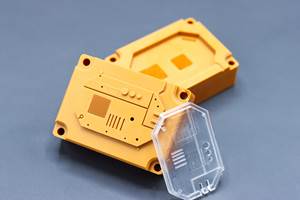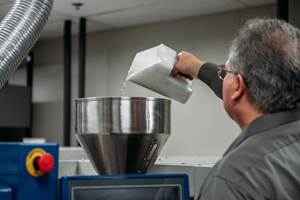Pursuing More Sustainable Plastic Pallets
Chilean lithium producer employs local molder with a specialized Engel duo 2-platen press to shift to pallets made from reclaimed plastics.
In ´óĎó´«Ă˝ for 50 years, Comberplast has spent the last 25 of those specializing in integrating recycled material into its injection molding, including adding in-house capacity for resin reclaim. Over the last eight years, it has further refined that focus into a new venture, Atando Cabos, which roughly translates from Spanish to “connecting the dots.”

From left, Julio Compagnon and his son, with Julia Kuehhas and Klaus Fellner of Engel, at Engel’s tech center in St. Valentin, Austria.
Source: Engel
The dots here are the various points along a custody chain that touch a plastic product. These products, despite the utility of the material they’re made from, have become environmental waste in their end of life. “We love plastic, but we also love nature,” explains Beltrán Orrego, development manager at Atando Cabos. “Whenever we see plastic where it shouldn’t be, we start figuring out how to fix the problem. How are we going to connect the different players of the value chain to be able to recover plastics from places they shouldn’t be?”
The first misplaced plastic waste it recovered — and dots the company connected — came from the salmon-farming industry in southern Chile’s Patagonia region. On vacation there, Michel Compagnon, Atando Cabos’ co-founder and Comberplast commercial manager, was struck by the region’s natural beauty and the presence of fishing waste in the form of nets and ropes. When Compagnon packed for home, he included some of the ropes found in Patagonia, hauling them back to Comberplast to see if the plastic was salvageable.
After some testing, Comberplast determined the detritus was reclaimable, and today, the company’s facility continuously receives trucks hauling fishing industry waste from Chile’s south after connecting the relevant dots among the local fishing industry, government and waste management there.
Atando Cabos’ reclaimed material was molded into floor tiles at machine partner Engel’s NPE2024 booth. At the show, Atando Cabos initiated its latest dot-connecting venture, purchasing a specialized Engel press to mold reusable plastic pallets from reclaimed materials for one of the largest suppliers of lithium in the world, Santiago-headquartered SQM Lithium. SQM uses the pallets to ship bulk bags of lithium and its derivatives all around the world.
After SQM reached out to the Chilean branch of Rehrig Pacific Company (RPC) — a lead pallet provider to the region and a key ´óĎó´«Ă˝ partner of Atando Cabos (who recovers and transforms material into RPC pallets) — about sourcing pallets from its reclaimed material, it realized it might have internal plastic waste that could also be reclaimed. SQM, RPC and Atando Cabos did testing and verified that the lithium producer’s plastic scrap could also be incorporated. “[SQM] is not only going to be removing as much material as they can from the south,” Orrego says, “but they’re also going to be using as much material as they can from their own operations.”
The NPE-purchased 2,200-ton two-platen hydraulic duo 51060/2000 tech PRO will run a new stack tool for the custom pallets, which feature steel inserts, with production scheduled to begin in January 2025. Normally, pallet molding at Comberplast entails batch work for the two-piece parts, so there’s a production run of top halves before switching to bottom halves. For the SQM job, however, the new stack mold, running 24/5, will enable Comberplast to mold both halves of the pallet simultaneously. Outfitted with Engel’s iQ weight control, weight monitor, melt control and clamp control, the optimized press is Comberplast’s eighth Engel machine, with previous presses ranging in clamp force from 250 to 1,100 metric tons. Comberplast and Atando Cabos’ willingness to experiment has made it a valued “testing” hub for equipment and material suppliers.
“I think one of our main benefits or values is we are very brave/crazy when it comes to trying new things,” Orrego says. “Collaboration is a word that’s used too much sometimes, but this is a collaboration in the real sense — every time it is connected to a real kilogram of material being reclaimed.”
Related Content
Make Every Shot Count: Mold Simulation Maximizes Functional Parts From Printed Tooling
If a printed tool only has a finite number of shots in it, why waste any of them on process development?
Read MoreThermoformed Container Keeps Battery Cells Safe
Despite last-minute design changes and other unexpected roadblocks, thermoformer TriEnda works with a key supplier on innovative reusable shipping container.
Read MoreOptical Sorting for Color Flexibility in Recycled Plastics
Aaron Industries added optical sorting to its operation, expanding capabilities to meet the color needs of customers.
Read MoreMarket Changes Spur Industrial Recycler to Enhance Capabilities in Clear Plastic Reprocessing
Butler MacDonald found new ´óĎó´«Ă˝ and flexibility thanks to a big step-up in purging efficiency.
Read MoreRead Next
Building an Ocean-Bound Plastics Supply Chain
Atando Cabos, working with partners ExxonMobil and Engel, is taking discarded fishing rope and transforming it into raw material to reincorporate into the production chain as long-term recyclable products.
Read MoreTwo-Stage Process Converts Post-Consumer Recyclate Into New Molded Parts
The new machine from Engel separates scrap plasticizing and injection into two independent process steps within one machine.
Read More










